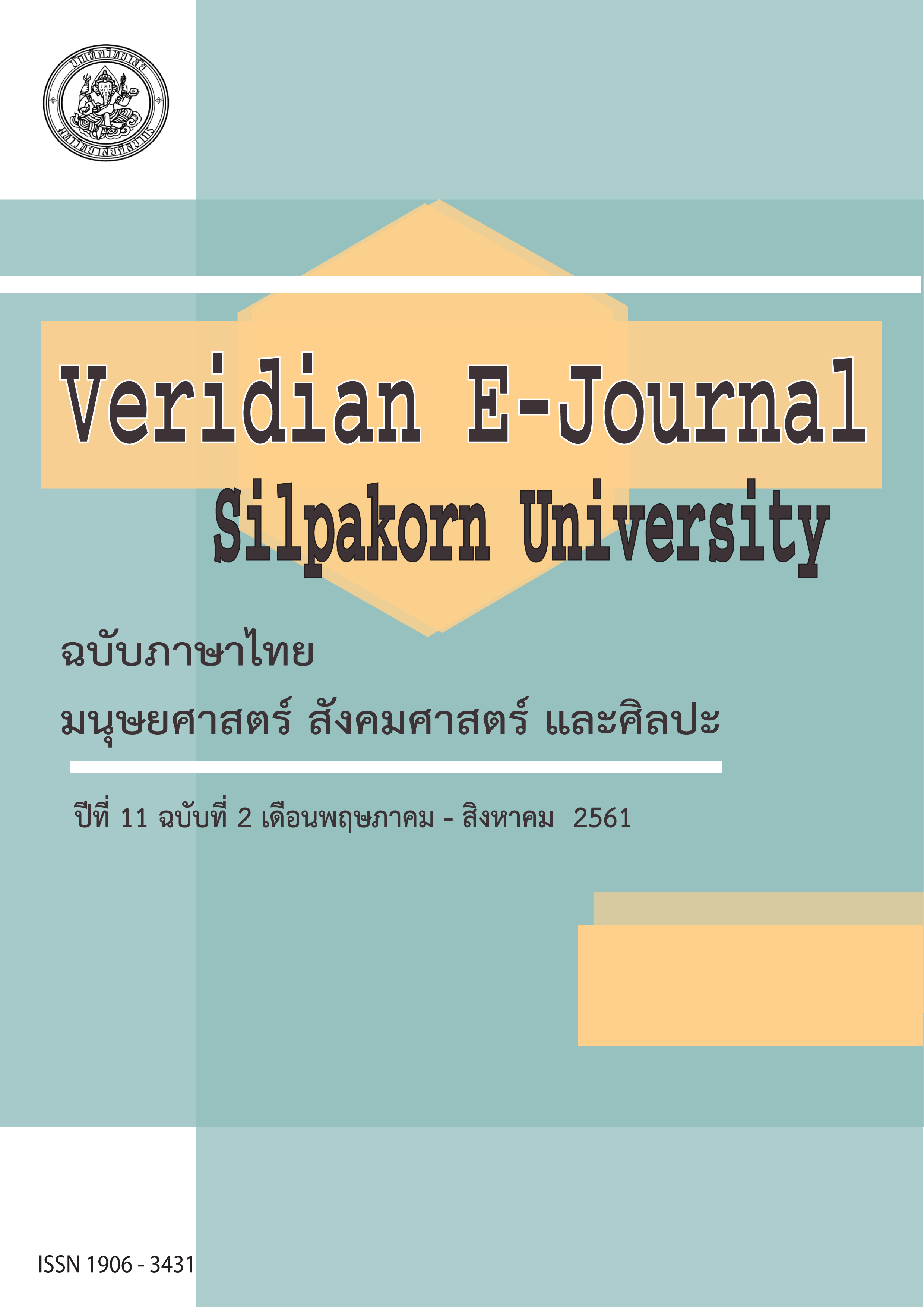การศึกษาเทคนิคการเสริมต่อความรู้ (Scaffolding) ในการฝึกอบรม Microsoft Excel 2010 (The Study of Scaffolding in the Microsoft Excel 2010 Workshop)
Main Article Content
Abstract
การวิจัยครั้งนี้อยู่บนพื้นฐานของการเสริมต่อความรู้ (Scaffolding) ของ Vygotsky ซึ่งเชื่อว่าการมีปฏิสัมพันธ์ทางสังคมมีบทบาทในการพัฒนาสติปัญญา การมีปฏิสัมพันธ์กับผู้ที่มีความรู้มากกว่าในสิ่งแวดล้อมที่สนับสนุนจะส่งผลให้ผู้เรียนสามารถพัฒนาสติปัญญาในการสร้างความคิดโดยตนเองได้ (Lindsay, L., Janet, S., and Anne, W., 2010) Vygotsky ยังเชื่ออีกว่าเมื่อใดก็ตามที่ผู้เรียนไม่สามารถพัฒนาความรู้ต่อไปได้ด้วยตนเองนั่นยังมิใช่จุดสิ้นสุดความสามารถที่แท้จริง หากแต่ผู้เรียนได้รับความช่วยเหลือจากผู้ที่มีความรู้ความสามารถมากกว่า (More Knowledgeable Other: MKO) ผู้เรียนจะสามารถพัฒนาตนเองต่อไปได้ (Lisa, A. E., 2004) วัตถุประสงค์ของการวิจัยเพื่อศึกษาเทคนิคการเสริมต่อความรู้ (Scaffolding) ที่เกิดขึ้นระหว่างผู้ให้การฝึกอบรม (Trainer) และผู้ได้รับการอบรม (Trainee) ในบริบทการฝึกอบรม Microsoft Excel 2010 ดังนั้นจึงดำเนินการวิจัยตามรูปแบบวิจัยเชิงธรรมชาติ (Naturalistic Approach) โดยประชากรในการวิจัย คือ บุคลากรบริษัท ทะเลไทย จำกัด จำนวน 7 คน ได้มาโดยความสมัครใจ
ผลการวิจัยพบว่าเทคนิคการเสริมต่อความรู้ (Scaffolding) เกิดขึ้นใน 14 สถานการณ์ เรียงลำดับความถี่สูงสุดไปต่ำสุดมี 6 กลุ่ม ดังนี้ (1) MKO แบ่งปันประสบการณ์ (Sharing) สร้างแรงบันดาลใจ และกระตุ้นให้ผู้ได้รับการอบรม (Trainee) คนอื่นๆ อยากเรียนรู้ และลงมือปฏิบัติ (2) ผู้ให้การอบรม (Trainer) สังเกตพฤติกรรมของผู้ได้รับการอบรม (Trainee) และถามปัญหาหรือตั้งคำถามให้ผู้ได้รับการอบรม (Trainee) คิดทบทวน คิดวิเคราะห์ และผู้ได้รับการอบรม (Trainee) ลงมือปฏิบัติชิ้นงาน (3) ผู้ให้การอบรม (Trainer) หรือ MKO อธิบายเพิ่มเติม หรือยกตัวอย่างเชื่อมโยงกับประสบการณ์เดิมของผู้ได้รับการอบรม (Trainee) (4) ผู้ได้รับการอบรม (Trainee) ตื่นเต้นกับการทำชิ้นงาน จดขั้นตอน และปฏิบัติตามที่ผู้ให้การอบรม (Trainer) ทำต้นแบบให้ดู (5) ผู้ได้รับการอบรม (Trainee) คนอื่นๆ สังเกต และเรียนรู้ไปพร้อมๆ กันระหว่างที่มีการเสริมต่อความรู้ (Scaffolding) (6) ผู้ได้รับการอบรม (Trainee) ร่วมทำชิ้นงานพร้อมๆ กับ MKO เมื่อทำชิ้นงานสำเร็จ จึงร่วมกันหาวิธีทำชิ้นงานให้น่าสนใจขึ้น
ผู้วิจัยนำข้อมูลมาวิเคราะห์ สร้างข้อสรุปประเภท และความสัมพันธ์ของการเสริมต่อความรู้ (Scaffolding) ได้ 3 ประเภท ได้แก่
(1) Internal (Within Individual) ภายในตัวของแต่ละบุคคล เป็นกระบวนการทางจิตใจ ความคิดภายในของผู้ได้รับการฝึกอบรม (Trainee) แต่ละบุคคลมีการซึมซับ หรือการนำเอาความรู้ที่ได้รับการเสริมต่อความรู้ (Scaffolding) ในบริบทนั้นๆ มาสะท้อนคิด (Reflection) เชื่อมโยงไปสู่การปฏิบัติ
(2) Intranal (Among Trainee/MKO) การมีปฏิสัมพันธ์กับบุคคลอื่นโดยการแนะนำ การอธิบาย การยกตัวอย่างประกอบ การแบ่งปัน (Sharing) ระหว่างผู้ได้รับการฝึกอบรม (Trainee) คนอื่นๆ หรือ MKO หรือผู้ให้การอบรม (Trainer) รูปแบบการมีปฏิสัมพันธ์ที่เกิดขึ้นระหว่างเสริมต่อความรู้ (Scaffolding) ที่ปรากฏมี 2 รูปแบบ ดังนี้
รูปแบบที่ 1 การเสริมต่อความรู้ (Scaffolding) โดยได้รับคำแนะนำ การอธิบาย การยกตัวอย่างประกอบ การแบ่งปัน (Sharing) ประสบการณ์จาก MKO ทั้งผู้ให้การอบรม (Trainer) หรือผู้ได้รับการฝึกอบรม (Trainee) คนอื่นๆ ทุกคนมีส่วนร่วมในการเรียนรู้ และแสดงบทบาทของ MKO ในสถานการณ์ต่างๆ
รูปแบบที่ 2 การเสริมต่อความรู้ (Scaffolding) โดยการร่วมมือกันหาคำตอบระหว่างผู้ได้รับการฝึกอบรม (Trainee) คนอื่นๆ ที่มีความรู้ความสามารถ ศักยภาพในการเรียนรู้เรื่องนั้นๆ เท่าๆ กัน
(3) External (Trainer and context or other resources) ได้แก่ ผู้ให้การฝึกอบรม (Trainer) และบริบทการเรียนรู้ หรือทรัพยากรอื่นๆ ที่เกี่ยวข้องกับการฝึกอบรม มีผลต่อการเสริมต่อความรู้ (Scaffolding) ที่เกิดขึ้นในแต่ละช่วงเวลา
This research based on scaffolding of Vygotsky theory. Vygotsky believed social interaction plays crucial role in the development of cognition. The interaction with more knowledgeable other (MKO) in a supportive environment could help learner construct knowledge by themselves (Lindsay, L., Janet, S., and Anne, W., 2010). In addition Vygotsky believed real ability of learner could further develop after received help from MKO/ trainer (Lisa, A. E., 2004). The purpose of this research was to study scaffolding technique occurring between trainer and trainee in Microsoft Excel 2010 training context. Research was conducted by naturalistic approach. The population 7 employees of Taley Thai Company (alias) that they voluntarily joined the research.
The research findings were scaffolding occurred in 14 scenarios. Sorted by frequency order as following (1) MKO’s sharing experience inspired and encouraged other trainees to learn and ate. (2) Trainer observed behavior’s trainees and asked the questions that encouraged trainee to review, critically think and ate. (3) Trainer/ MKO explained or gave example that related with prior experience of trainees. (4) Trainee were excited by workshop participating, took notes taking and following the trainers demonstration. (5) Other trainees observed and learned together during scaffolding. And (6) Trainee cooperatively involved in workshop together with MKO. After their success, they eager to find other new ways of doing how to made it more interesting.
From the phenomena in training sessions, the researcher analyzed the data, then concluded into scaffolding’s type and relationship as follows:
(1) Internal (Within Individual) as internal process of individual involving mind, thought. Trainees absorbed or brought learning experience from scaffolding to reflection and linked to practice.
(2) Intranal (Among Trainee/MKO) interaction among trainees or MKO, interaction with other persons by instruction, explanation, example and sharing among other trainees, trainer and MKO. The interaction pattern that occurred during scaffolding as follow;
Format 1: Scaffolding by instructing, explaining, sharing experience from trainer/ MKO / other trainees. Everyone was involved in learning and role play of MKO in various situations.
Format 2: Scaffolding by collaborating with other trainees who had equally knowledge.
(3) External (Trainer and context or other resources) involved trainer and leaning context or other resources that related training, knowledge in Microsoft Excel 2010 contents, knowledge of scaffolding and researcher’s experience as a trainer.
